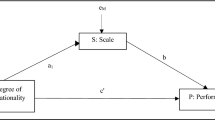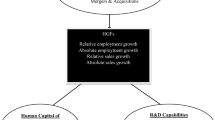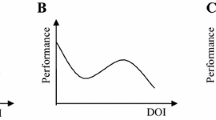Summary
Although there are numerous empirical examinations of the relationship between foreign direct investment and corporate performance, researchers to date have not been able to reach a consensus on findings. In this article, we report the results of an inquiry into the relationship between foreign direct investment and operational performance (i.e., labour productivity). Our findings indicate that a U-curve best reflects the form of the relationship and that the curve’s inflection point is dependent on firms’ industrial membership.
In conceptual terms, these results lend support to organizational learning theory. By relocating production facilities worldwide, firms can reap labour cost advantages. However, international production relocation can also come along with an employee qualification disadvantage that requires costly and time-consuming workforce training. Therefore, managers should aim for including both productivity components (i.e., labour costs and employee qualification) into their relocation decision-making process. Only then can the strategic instrument ‘international production relocation’ foster sustainable corporate success.
Similar content being viewed by others
Literatur
Alcatel Microelectronics (1998), Globalisierung mit “Systems on two Chips”, in: Elektronik -Munich-, Vol. 47, S. 12–15.
Annavarjula, Madan/Beldona, Sam (2000), Multinationality-performance relationship: A review and reconceptualization, in: The International Journal of Organizational Analysis, Vol. 8, S. 48–67.
Argyris, Chris/Schön, Donald (1978), Organizational Learning: A theory of action perspective, Reading: Addison-Wesley.
Barkema, Harry/Vermeulen, Freek (1998), International expansion through start-up or acquisition: A learning perspective, in: Academy of Management Journal, Vol. 41, S. 7–26.
Berger, Roland (1997), Chancen und Risiken der Internationalisierung aus Sicht des Standortes Deutschland, in: Krystek, Ulrich/Zur, Eberhard (Hrsg.), Internationalisierung. Eine Herausforderung für die Unternehmensführung, S. 19–33.
Contractor, Farok/Kundu, Sumit/Hsu, Chin-Chun (2003), A three-stage theory of international expansion: the link between multinationality and performance in the service sector, in: Journal of International Business Studies, Vol. 34, S. 5–18.
Cooke, William (2001), The effects of labour costs and workplace constraints on foreign direct investment among highly industrialized countries, in: International Journal of Human Resource Management, Vol. 12, S. 697–716.
Dafne (2000), A financial database of major German companies with financial analysis software, Creditreform/Bureau van Dijk.
Doleschal, Reinhard (1987), Automobilproduktion und Industriearbeiter in Brasilien: eine Untersuchung über Volkswagen do Brasil und die internationale Arbeitsteilung.
Eden, Haro (1997), Kleine und mittlere Unternehmen im Prozess der Internationalisierung, in: Krystek, Ulrich/Zur, Eberhard (Hrsg.), Internationalisierung. Eine Herausforderung für die Unternehmensführung, S. 43–75.
Egger, Peter/Pfaffermayr, Michael (2001), A note on labour productivity and foreign inward direct investment, in: Applied Economics Letters, Vol. 8, S. 229–232.
Emmrich, Volkhard (1997), Globale Produktionsstandortstrategien, in: Krystek, Ulrich/Zur, Eberhard (Hrsg.), Internationalisierung. Eine Herausforderung für die Unternehmensführung, S. 233–248.
Eriksson, Kent/Johanson, Jan/Majkgard, Anders/Sharma, Deo (2001), Time and experience in the internationalization process, in: Zeitschrift für Betriebswirtschaft, Vol. 71, S. 21–43.
Frankfurter Allgemeine Zeitung (1999), Germany’s top 500 — A handbook of Germany’s largest corporations, Information Services.
Funk, Joachim (1998), Mannesmann im Trend globaler Märkte und internationaler Arbeitsteilung, in: zfbf, Vol. 50, S. 183–196.
Gambke, Thomas/Klevers, Thomas (1997), Produktion von High-Tech-Teilen in Tschechien — Erfahrungen, Risiken und Chancen, in: Krystek, Ulrich/Zur, Eberhard (Hrsg.), Internationalisierung. Eine Herausforderung für die Unternehmensführung, S. 249–259.
Gerpott, Torsten/Walter, Andreas (1999), Internationale Diversifikation, F&E-Intensität und Erfolg von großen Industrieunternehmen, in: zfbf, Vol. 51, S. 1101–1122.
Gomes, Lenn/Ramaswamy, Kannan (1999), An empirical examination of the form of the relationship between multinationality and performance, in: Journal of International Business Studies, Vol. 30, S. 173–188.
Handbuch der deutschen Aktiengesellschaften, Jahresbänder 1995–2000.
Hitt, Michael/Hoskisson, Robert/Kim, Hicheon (1997), International diversification: Effects on innovation and firm performance in product-diversified firms, in: Academy of Management Journal, Vol. 40, S. 767–798.
Huber, Gerhard (1991), Organizational learning: The contributing process and the literature, in: Organization Science, Vol. 2, S. 88–115.
Khawar, Mariam (2003), Productivity and foreign direct investment: Evidence from Mexico, in: Journal of Economic Studies, Vol. 30, S. 66–76.
Kogut, Bruce (1985), Designing global strategies: Comparative and competitive value-added chains, in: Sloan Management Review, Vol. 26, S. 15–18.
Kutschker, Michael/Schmid, Stefan (2002), Internationales Management.
Larudee, Mehrene/Koechlin, Tim (1999), Wages, productivity, and foreign direct investment flows, in: Journal of Economic Issues, Vol. 33, S. 419–426.
Liu, Xiaming/Parker, David/Vaidya, Kirit/Wei, Yingqi (2001), The impact of foreign direct investment on labour productivity in the Chinese electronics industry, in: International Business Review, Vol. 10, S. 421–439.
Nunnenkamp, Peter (2000), Globalisierung der Automobilindustrie: Neue Standorte auf dem Vormarsch, traditionelle Anbieter unter Druck?, Working Paper — Kiel Institute of World Economics.
Ramaswamy, Kannan (1992), Multinationality and performance: A synthesis and redirection, in: Advances in International Comparative Management, Vol. 7, S. 241–267.
Ruigrok, Winfried/Wagner, Hardy (2003), Internationalization and performance: An organizational learning perspective, in: Management International Review, Vol. 43, S. 63–83.
Spindler, Manfred/Dittrich, Gunther/Weimer, Walter (2000), Globalisierung in der chemischen Industrie — eine Begriffsbestimmung, in: Chemie in unserer Zeit, Vol. 34, S. 232–239.
Sullivan, Daniel (1994a), Measuring the degree of internationalization of a firm, in: Journal of International Business Studies, Vol. 25, S. 325–342.
Sullivan, Daniel (1994b), The “threshold of internationalization”: Replication, Extension, and Reinterpretation, in: Management International Review, Vol. 34, S. 165–186.
Tüselmann, Heinz-Josef (1998), Standort Deutschland: German direct foreign investment — Exodus of German industry and export of jobs?, in: Journal of World Business, Vol. 33, S. 295–313.
United Nations Conference on Trade and Development, UNCTAD (1999), World Investment Report 1999 — Foreign Direct Investment and the Challenge of Development.
Van de Ven, Andrew/Poole, Marshall (1995), Explaining development and change in organizations, in: Academy of Management Review, Vol. 20, S. 510–540.
Author information
Authors and Affiliations
Corresponding author
Rights and permissions
About this article
Cite this article
Ruigrok, W., Wagner, H. Internationale Standortverlagerung und Mitarbeiterproduktivität: Eine empirische Untersuchung deutscher Industrieunternehmen. Schmalenbachs Z betriebswirtsch Forsch 57, 310–324 (2005). https://doi.org/10.1007/BF03372768
Published:
Issue Date:
DOI: https://doi.org/10.1007/BF03372768




